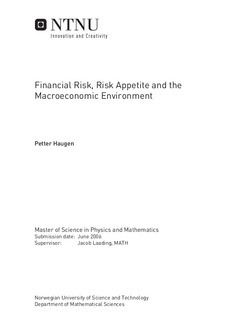Financial Risk, Risk Appetite and the Macroeconomic Environment
Master thesis
Permanent lenke
http://hdl.handle.net/11250/258358Utgivelsesdato
2006Metadata
Vis full innførselSamlinger
Sammendrag
This thesis seeks to establish a methodology to reveal whether the risk appetite held by investors is dependent on the macroeconomic environment and, if present, to quantify this dependency. To do so a generic model is built and a case study is carried out with data from DnBNOR. The available data consists of the daily profit and losses together with the number and volume of transactions made in a currency portfolio owned by DnBNOR and some selected timeseries on exchange rates, all against NOK. Also, timeseries on the gross national product and consumer price index are collected from Statistics Norway. In the process of building the model, the thesis sets out the theoretical foundation for different risk measurement concepts and gives a presentation of the theory on business cycles as this is used to classify and measure the macroeconomic environment. The model is built with a Bayesian approach and implemented in WinBUGS. The use of Bayesian statistics is motivated by different time resolution of the data; some of the data is observed every day while other parts are observed each quarter. The thesis' main idea is to decompose the relevant part of the economy in one microeconomic and one macroeconomic state. The microeconomic state is unique for each day while the macroeconomic state accounts for one quarter; together they give the expected risk appetite for each day. In this way the impact from the macroeconomic state is quantified and the results show that the macroeconomic state is statistically significant for the risk appetite. As this is a case study one needs more data and research before any universal valid conclusions can be made.
